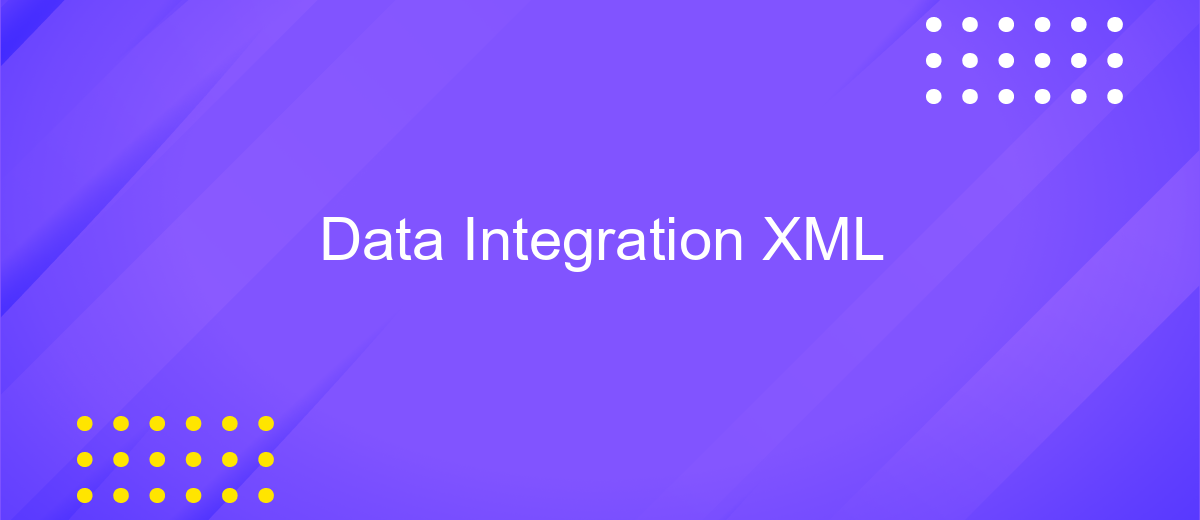Data Integration XML
Data integration using XML (Extensible Markup Language) is a powerful method for combining data from different sources into a unified format. This approach facilitates seamless data exchange, enhances interoperability, and ensures consistency across various systems. By leveraging XML's flexible and structured nature, organizations can efficiently manage and utilize diverse datasets, driving more informed decision-making and streamlined operations.
Data Integration XML
Data Integration using XML (Extensible Markup Language) is a powerful method for combining data from various sources into a unified view. XML's flexible and self-describing nature makes it an ideal choice for data integration tasks, allowing disparate systems to communicate seamlessly. By using XML, businesses can improve data consistency, streamline workflows, and enhance decision-making processes.
- Standardization: XML provides a standardized format for data representation, ensuring compatibility across different systems.
- Flexibility: Its hierarchical structure allows for the integration of complex data types.
- Interoperability: XML facilitates easy data exchange between heterogeneous systems.
- Scalability: XML can handle large volumes of data, making it suitable for enterprise-level integration.
- Extensibility: New data elements can be added without disrupting existing systems.
Overall, XML-based data integration offers a robust solution for organizations looking to unify their data sources. Its ability to standardize, flexibly structure, and efficiently exchange data makes it a cornerstone technology in modern data management strategies. As businesses continue to grow and evolve, leveraging XML for data integration will remain a critical component for achieving operational excellence and informed decision-making.
Data Integration XML: An Overview

Data integration using XML (Extensible Markup Language) is a powerful approach to combining data from different sources into a unified view. XML's flexibility and self-describing nature make it an ideal choice for data exchange between disparate systems. By providing a standardized format, XML ensures that data can be easily shared and understood across various platforms and applications, promoting interoperability and reducing the complexity of data integration tasks.
One of the key advantages of XML in data integration is its compatibility with numerous tools and services designed to facilitate seamless data exchanges. For instance, ApiX-Drive is a service that simplifies the integration process by allowing users to connect various applications without writing a single line of code. ApiX-Drive supports XML data formats, enabling automated data transfers and synchronization between systems, thus streamlining workflows and enhancing operational efficiency. This makes it an invaluable asset for businesses looking to leverage XML for their data integration needs.
Benefits of Data Integration XML

Data Integration using XML offers numerous advantages for businesses and organizations looking to streamline their data management processes. XML (eXtensible Markup Language) provides a flexible and standardized way to encode documents, making it easier to share and manipulate data across different systems and platforms.
- Interoperability: XML facilitates seamless data exchange between disparate systems, regardless of the underlying technology.
- Scalability: XML's hierarchical structure allows for easy expansion and adaptation as data requirements grow.
- Data Consistency: Using XML ensures that data is consistently formatted and validated, reducing errors and improving data quality.
- Flexibility: XML can represent complex data structures, making it suitable for a wide range of applications and industries.
- Cost-Effective: XML is a widely adopted standard, supported by numerous tools and technologies, which can reduce development and maintenance costs.
In conclusion, integrating data with XML not only enhances the efficiency and effectiveness of data management but also provides a robust framework for future growth and innovation. By leveraging XML, organizations can achieve greater interoperability, scalability, and reliability in their data operations.
How Data Integration XML Works

Data Integration XML works by enabling seamless data exchange between disparate systems through a standardized format. XML, or Extensible Markup Language, provides a flexible and structured way to represent data, making it easy to transport and interpret across different platforms and applications.
The process typically starts with the extraction of data from various sources, such as databases, APIs, or flat files. This data is then transformed into XML format, preserving its structure and meaning. The XML data can then be validated against predefined schemas to ensure consistency and accuracy.
- Extraction: Gathering data from multiple sources.
- Transformation: Converting data into XML format.
- Validation: Ensuring data adheres to XML schemas.
- Integration: Combining XML data into a unified view.
Once the data is in XML format, it can be integrated into a central repository or distributed to various systems as needed. This approach not only facilitates data sharing but also enhances data quality and consistency, making it a powerful tool for organizations seeking to leverage their data assets effectively.
Conclusion
In conclusion, Data Integration using XML proves to be a robust and flexible approach for seamlessly combining data from diverse sources. XML's self-descriptive nature and platform independence make it an ideal choice for enterprises looking to streamline their data workflows. By leveraging XML, organizations can ensure that their data is both accessible and interoperable, thus enhancing decision-making processes and operational efficiency.
Moreover, tools like ApiX-Drive significantly simplify the integration process by providing user-friendly interfaces and automated workflows. These services enable even non-technical users to set up complex integrations without extensive coding knowledge. As a result, businesses can save time and resources while ensuring that their data systems remain synchronized and responsive to changing needs. Ultimately, the strategic use of XML for data integration, complemented by powerful tools like ApiX-Drive, positions organizations to thrive in today's data-driven landscape.
FAQ
What is Data Integration XML?
Why is XML commonly used for data integration?
What are the key challenges in XML data integration?
How can I automate XML data integration processes?
What are the benefits of using an integration platform for XML data integration?
Apix-Drive is a universal tool that will quickly streamline any workflow, freeing you from routine and possible financial losses. Try ApiX-Drive in action and see how useful it is for you personally. In the meantime, when you are setting up connections between systems, think about where you are investing your free time, because now you will have much more of it.

